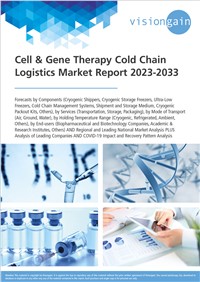This report will prove invaluable to leading firms striving for new revenue pockets if they wish to better understand the industry and its underlying dynamics. It will be useful for companies that would like to expand into different industries or to expand their existing operations in a new region.
Favourable Initiatives and Programs for Easier Access to Cell and Gene Therapy Driving Market Growth
Patient access programs are initiatives designed to facilitate the access of patients with rare or serious diseases to cell and gene therapies. These programs offer various types of support to ensure that patients receive effective therapy in a timely manner. Support may include financial assistance, education and awareness, regulatory guidance, and transportation assistance. Due to the high cost of these therapies, affordability becomes a significant challenge for patients. To address this issue, governments and biopharmaceutical companies have implemented patient access programs that provide financial aid and reimbursement schemes, aiming to extend the reach of these therapies to patients. For examples, Novartis provide Patient Assistance NOW Program, a patient access programs for cell and gene therapy. This program offers financial assistance and support services to eligible patients receiving Kymriah and other medications from Novartis.
However, the cost associated with the storage and temperature-controlled transport of biologics is essential to maintain the integrity and effectiveness of these specialized medicines. Specifically, biologics that necessitate ultra-low temperature storage and transportation, like gene therapies and cell-based therapies, can incur significant expenses. This high cost is expected to act as a limiting factor for the growth of the cell and gene therapy cold chain logistics market.
Stringent Government Regulations to Hamper Industry Growth
Various governments have implemented stringent regulations regarding the importation of cell and gene therapeutics. Regulatory bodies require manufacturers to meet specific safety standards before granting market approval and allowing distribution. Similar rules apply to the importation of biologics, including vaccines and cell and gene therapies. Certain countries have additional regulations such as import permits, labeling requirements, storage information, and customs clearance documents for imported biologics. Logistic companies, along with their regulatory teams, must provide all necessary documentation to ensure a safe and legal process through the regulatory authorities. Moreover, such regulations can present obstacles to importing biotherapeutics into developing countries with less established regulatory frameworks, thus limiting patient access to these treatments in those regions.
What Questions Should You Ask before Buying a Market Research Report?
- How is the vaccine contract manufacturing market evolving?
- What is driving and restraining the vaccine contract manufacturing market?
- How will each vaccine contract manufacturing submarket segment grow over the forecast period and how much revenue will these submarkets account for in 2033?
- How will the market shares for each vaccine contract manufacturing submarket develop from 2023 to 2033?
- What will be the main driver for the overall market from 2023 to 2033?
- Will leading vaccine contract manufacturing markets broadly follow the macroeconomic dynamics, or will individual national markets outperform others?
- How will the market shares of the national markets change by 2033 and which geographical region will lead the market in 2033?
- Who are the leading players and what are their prospects over the forecast period?
- What are the vaccine contract manufacturing projects for these leading companies?
- How will the industry evolve during the period between 2023 and 2033? What are the implications of vaccine contract manufacturing projects taking place now and over the next 10 years?
- Is there a greater need for product commercialisation to further scale the vaccine contract manufacturing market?
- Where is the vaccine contract manufacturing market heading and how can you ensure you are at the forefront of the market?
- What are the best investment options for new product and service lines?
- What are the key prospects for moving companies into a new growth path and C-suite?
You need to discover how this will impact the vaccine contract manufacturing market today, and over the next 10 years:
- Our 322-page report provides 119 tables and 187 charts/graphs exclusively to you.
- The report highlights key lucrative areas in the industry so you can target them – NOW.
- It contains in-depth analysis of global, regional and national sales and growth.
- It highlights for you the key successful trends, changes and revenue projections made by your competitors.
This report tells you TODAY how the vaccine contract manufacturing market will develop in the next 10 years, and in line with the variations in COVID-19 economic recession and bounce. This market is more critical now than at any point over the last 10 years.
Forecasts to 2033 and other analyses reveal commercial prospects
- In addition to revenue forecasting to 2033, our new study provides you with recent results, growth rates, and market shares.
- You will find original analyses, with business outlooks and developments.
- Discover qualitative analyses (including market dynamics, drivers, opportunities, restraints and challenges), cost structure, impact of rising vaccine contract manufacturing prices and recent developments.
This report includes data analysis and invaluable insight into how COVID-19 will affect the industry and your company. Four COVID-19 recovery patterns and their impact, namely, “V”, “L”, “W” and “U” are discussed in this report.
Segments Covered in the Report
Component
- Cryogenic Shippers
- Cryogenic Storage Freezers
- Ultra-Low Freezers
- Cold Chain Management Systems
- Shipment and Storage Medium
- Cryogenic Packout Kits
- Others
Services
- Transportation
- Storage
- Packaging
Mode of Transport
- Air Transport
- Ground Transport
- Water Transports
Holding Temperature Range
- Cryogenic
- Refrigerated
- Ambient
- Others
End-users
- Biopharmaceutical & Biotechnology Companies
- Academic & Research Institutes
- Others




